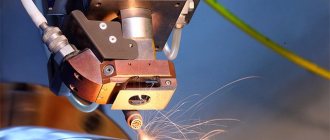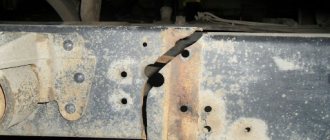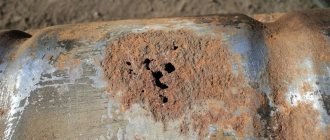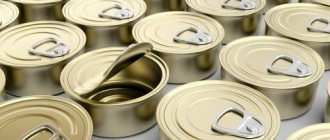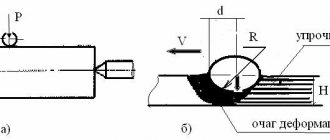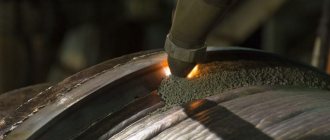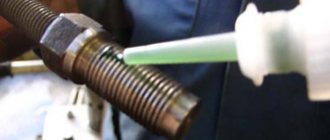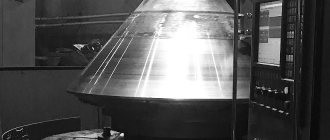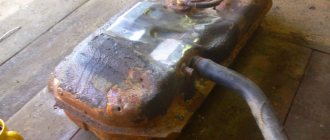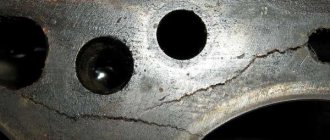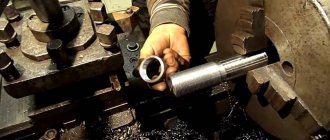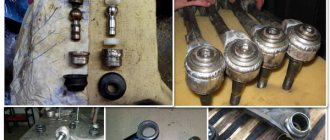Restoration of parts by surfacing and welding is a technological process of eliminating, by welding and surfacing, unacceptable defects formed during the operation of equipment. Repair welding can be distinguished as an independent production process carried out for the purpose of restoring structures, assemblies, parts damaged under the influence of operational loads and factors or for other reasons.
The decision on the possibility and feasibility of performing repair work using welding and surfacing is made taking into account all the requirements specified in the documentation for the design, manufacture and operation of the structure being repaired.
Repairs of critical metal structures must be carried out according to specially developed design and technological documentation, taking into account the actual state of the metal structure (assembly, part), the causes of damage and the absence of loads on the product being repaired during repair work.
Methods for restoring parts by surfacing and welding
Restoration of operational damage can be performed using various welding methods:
- automatic submerged arc welding with solid or cored wire
- mechanized gas-shielded electric arc welding with solid or flux-cored wire
- argon arc automatic and mechanized welding with filler wire
- plasma welding and plasma spraying
- manual electric arc welding with a coated electrode.
In relation to the products offered by our company, namely coated electrodes and welding wire, we will focus on two methods of electric arc welding - manual arc welding with a consumable (coated) electrode and mechanized arc welding with a consumable electrode in a shielding gas environment. When using self-shielded flux cored welding wires, the use of shielding gas is not necessary.
Application experience.
Currently, we have accumulated extensive experience in restoring parts by surfacing and welding in the process of repairing equipment at enterprises in various industries.
Here are some examples from mining companies:
1) Excavator bucket repair
The bucket, being a replaceable component of an excavator, is subjected to intense mechanical and shock-abrasive loads during operation and needs to be replaced more often than any other component. Using repair technologies, individual parts of the bucket are replaced, as well as subsequent additional armoring of the most loaded fragments. Materials used: Capilla 51 Ti, CrNiMo, E-7018 electrodes, for armoring – Capilla 54 W electrodes or DT-DUR 609 wire. Durability after repair is up to 2-3 years, armor durability – 1 year.
2) Repair of excavator bucket rocker arm
Typical defects are cracks and wear of the lugs. Materials are selected depending on the steel grade, most often Capilla 51 T and E-7018 with welding of additional linings. Eyes - surfacing E-7018 and boring on a boring complex WS-3. Guaranteed durability for at least 1 year.
3) Repair of the working body of an earthmoving machine
Restoration of the working crown by surfacing. Surfacing and grinding are done manually. Materials: Capilla 53 type electrodes. The durability of repaired elements depends primarily on the soil, but is no worse than new ones.
4) Restoration of grab gripper by surfacing
The nature of wear is breakage (broken) or abrasion of the paw tips. Surfacing can be done with or without a prosthesis, depending on wear. Material: Capilla 54 W type electrodes, surfacing is carried out in 3-4 passes. Durability of restoration up to 1 year.
5) Repair by surfacing of teeth of excavator ring gears
The nature of the repair is the restoration of broken teeth, chips, and chips. Materials: electrodes Capilla 51 Ti, Capilla 52 K. Typically, such work is carried out on site without dismantling. Surfacing is carried out, and then manual grinding is carried out according to a template in minus tolerance. Durability is unlimited, provided that the operating rules are followed.
6) Excavator body repair
Defects – numerous cracks in the body and frame of the excavator. Materials: electrodes Capilla 51 Ti, CrNiMo, E-7018 with welding of additional pads. Durability up to 2 years, subject to compliance with operating instructions.
7) Repair of tension wheel
Wear – working surfaces, surface cracks. To restore the geometry of the wheel, surfacing is carried out with DT-DUR 250 K flux-cored wire. Repair of cracks using welding with Capilla 51 Ti electrodes followed by mechanical processing. Durability of at least 3 years, subject to compliance with operating rules.
Wheel axle restoration
Axles - surfacing with wire type E50-E60A (E 7018) followed by mechanical processing. Durability – 1 year. For example, new axles last no more than 1 year.
9) Restoration of wheel support struts by surfacing
Support stand. Surfacing of internal and external surfaces. Repair of extruded fragments. Materials: welding electrodes or wire type E-7018 followed by mechanical processing. Durability depending on operating conditions is 2-3 years.
10) Repair of track rollers
Similar to repairing a support post. Surfacing of the outer surface to restore the geometry of the support roller. Materials: E-7018 type welding wire followed by mechanical processing. Durability depending on operating conditions is 2-3 years.
11) Restoring the axle box
Similar to repairing a support post. Surfacing of the inner surface to restore the geometry of the roller axle box. Materials: E-7018 type welding wire followed by mechanical processing. Durability depending on operating conditions is 2-3 years.
12) Making a bimetallic bushing
Surfacing of the inner surface of a steel bushing. Manufacturing of a steel bushing followed by internal surfacing with a copper alloy. Materials: welding wire DT-CuAl8. After mechanical processing, the thickness of the working layer is 4 mm. Durability approximately 10 times better than pure bronze
13) Restoration of wheel flanges and crane wheels
For cranes and wheel sets, forged or cast wheels made of steel 65G, 50 G2, etc. are used. During operation, as a result of wear, the diameter of the tread surface decreases and the wheel flange becomes thinner. The wear resistance of wheels largely depends on the hardness of the working layer, however, too high a hardness leads to rapid wear of the rail, the replacement and (or) restoration of which is much more expensive. The optimal restoration methods should be those that ensure the hardness of the wheel tread surface is somewhat less than the hardness of the rail.
It is most advisable to restore wheelsets by surfacing, provided that the wear of the treading surface does not exceed 10 mm and the flange is worn by no more than half, for running wheels with a diameter of up to 800 mm.
Before surfacing, the wheel is ground to remove cracks, dents, and chips. Wheels can be restored many times, but no more than 5-6 times. Materials: DT-DUR 250 K wire, and in case of large wear, surfacing of the buffer sublayer with X70T4 wire. Durability: 3-4 years.
14) Repair of tracks of tracked vehicles and tracked conveyors
Typical steel for making tracks is 110G13. Materials: Capilla 51 Ti electrodes for surfacing the buffer and working layers. In some cases, it is advisable to additionally apply “armoring” using electrodes or cored wire such as DT-DUR 609. Durability is approximately the same as that of a new one - 1 year
15) Repair of housings, engine cylinder blocks
Defects - cracks, breaks, etc. Material: Capilla 43 electrodes. The durability of repaired blocks is assessed as for new ones.
16) Surfacing of crusher beaters
Crushers are used to crush rock. Crusher beaters, working under conditions of impact-abrasive and abrasive wear, are the most rapidly wearing parts of crushers, limiting their productivity. The wear resistance of welded blows is 1.5-2 times higher than the wear resistance of cast blows made of high-manganese steel 110G13. Repeated restoration of worn beats by repeated surfacing is possible.
Restoration by surfacing. Material: Capilla 51 Ti electrodes. For additional armoring, Capilla 54 W electrodes or DT-DUR 600 cored wire. When armored, the resistance is even higher than new ones made of 110G13 steel by about 2-3 times.
17) Repair by surfacing of crushing plants
Restoration by surfacing. Material: Capilla 51 Ti electrodes. For additional armor, Capilla 54 W electrodes or DT-DUR 600 cored wire. The durability is even higher than new ones by about 2-3 times.
18) Surfacing of feeder shaft teeth
Restoration of parts of geometric dimensions is carried out by surfacing with additional armor. Material: electrodes type E-7018, for armoring electrodes Capilla 54 W or Capilla 54-160 (5400). Durability depending on intensity of use.
19) Repair of the fender guide plate
Restoring defects mainly involves welding individual sheets (plates) with subsequent armoring. Materials: E-7018 electrodes, Capilla 54 W electrodes for armoring. Durability 1 year.
20) Refurbished repair of mine hoisting drums
Wear - numerous cracks in the body both outside and inside. Material: electrodes E 7018, Capilla 51 Ti. Durability – 1 year
21) Restoration of shafts by surfacing
Surfacing of teeth. Material: electrodes Capilla 51 Ti, Capilla 51 W, Capilla 52 K depending on the hardness of the gear block followed by mechanical hardness. processing. Surfacing of axles. Material: E-7018 or Capilla 52 K. Durability of at least 1 year depending on operating conditions.
22) Repair of pump impeller
The wheel is made of ICHH-28 alloy. Materials: Capilla 44 electrodes. Durability of at least 3 years.
23) Welding a steel hub to a cast iron wheel body
Material – Capilla 43 electrodes. Durability up to 0.5 year or more depending on operating conditions.
What does the repair involve?
The processes of welding and surfacing are fundamentally different . In the first case, the melt is used to join the parts. In the second, it acts as a working layer, which is applied to the surface of the part in order to restore its original dimensions.
There are situations when these functions coincide. An example is the restoration of the underbody of a car damaged by corrosion. At the same time, severely damaged areas are replaced with sheets of metal, cracks and holes are restored by surfacing.
In other cases, the wear on the axle or frame of the body part is completely restored by surfacing . At the same time, welding can be used to repair (for example) a crack on the same element.
Another example: welding a truck frame. Here, the elements of the supporting frame where cracks have arisen are welded, and the excavations in the eyes and grooves for fastening units, rods, axles, etc. are welded.
As for iron wear, choosing repair by surfacing is not always advisable . If an automobile plant produces the necessary components, repairs may come down to cutting out the worn part and then welding a new one.
As a rule, welding of a car body is used more often than surfacing on its parts. The reason is the nature of wear caused by the similarity of causes of damage during operation.
It doesn’t matter what brand it is: a VAZ 2109, a Hyundai Porter truck, a Lexus or an old Niva - the majority of body damage is due to corrosion and deformation of sheet metal during accidents.
